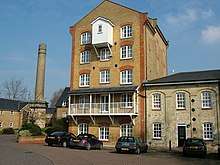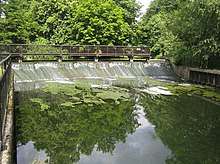Sele Mill
Sele Mill is a 19th-century mill building in Hertford, England. It has been converted into apartments.

A blue plaque on the building (Plaque #30561 on Open Plaques.) commemorates an earlier mill on the site, the country's first paper mill.[1]
History
A watermill on this site is mentioned in the Domesday Book of 1086. At that time Sele was a manor, separate from Hertford, but appears to have been a very small settlement: the recorded population was two households.[2] For most of its history, the mill used the power of the River Beane, a chalk stream which joins the River Lea at Hertford.
In the late 15th century the mill was converted into a paper mill by an entrepreneur called John Tate. As far as is known, this was the first paper mill in the country. It appears to have gone out of production around 1500,[3] and the facility was used for grinding corn again.
Mill race

Although water power is no longer used at the site, there is a 20th-century labyrinth weir on the River Beane designed to produce a head of water for the mill race. There is a programme of works to improve the ecological health of the river and it has been proposed to modify the weir which poses a barrier to fish migration.[4]
See also
References
- "Sele Mill: blue plaque 30561". Open Plaques. Retrieved 2020-05-31.
- "Sele". Open Domesday. Retrieved 2020-06-06.
- Richard L. Hills, ‘Tate, John (c.1448–1507/8)’, Oxford Dictionary of National Biography, Oxford University Press, 2004; online edn, Jan 2008 accessed 24 June 2015. Subscription or UK public library membership required.
- "River Beane" (PDF). Wild Trout Trust.